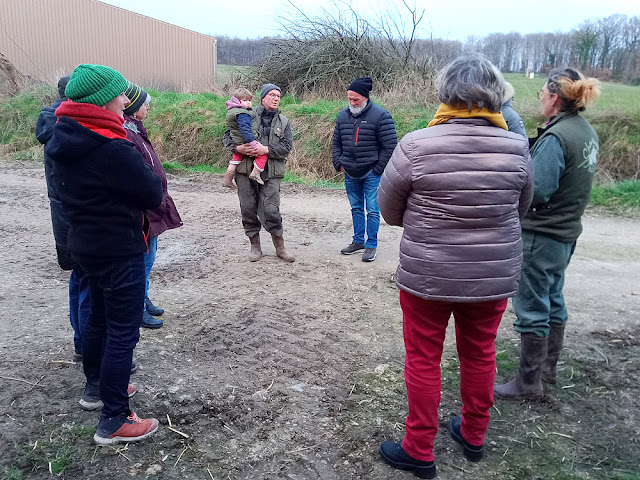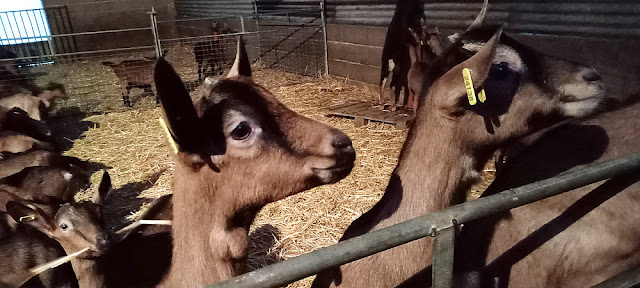On a very cold Wednesday evening I joined a visit to la Ferme des Effes, just outside of Preuilly sur Claise. It was part of a programme including a farm visit, a shared meal and a film. I attended the farm visit and the film. The theme was farm successions. This is a hot topic in the Sud Touraine, as a third of farmers here are ready to retire.
Charlotte's Dad, holding his grandson, talks about the farm. Charlotte is on the right.
La Ferme des Effes is in the process of being handed over from one generation to the next. Since 2016 Charlotte Mallet Bottemine has been taking over the management and day to day running of the farm. Her parents had come from farming families in Brittany but when it came time for them to start out on their own in the 1980s land was too expensive in Brittany, so they came to the Sud Touraine and bought les Effes.
The young goats noisily feeding on hay and straw.
The farm is now 90 hectares and the primary activity is dairy goats. The milk is sold to the Eurial co-operative at Tournon Saint Martin, where they make Sainte Maure de Touraine and Pouligny Saint Pierre AOC cheeses as well as their own brand Soignon. Charlotte also runs a herd of Charmoise ewes and sells fat lambs (to me, and to one of the local Michelin star restaurants, amongst others).
Inquisitive young dairy goats.
When she decided to take on the family farm in 2016 Charlotte spent the first couple of years getting a qualification in agriculture. Her parents are still involved with the work of the farm and the transition has been gradual, in slow, affordable steps. The land and material have been divided up so that ownership has transferred in batches to ensure the financial burden is not too great. Charlotte is very careful not to get carried away and investment in new equipment or buildings has been kept as low as possible. But a big new hangar with a solar panel roof went up last year.
The adult dairy goats, which are all the Alpine breed.
We were shown the young goats who will go on to join the herd. They were born in the autumn and are kept in cohorts of animals that are about the same weight. I'd met them already, when they were really little and still living in the pen with access to milk. Now they were munching extremely audibly on hay produced on the farm. Then we went to see the milking goats, which seemed to me to be quite big animals compared to other herds I've seen. The goats are all born and bred on the farm and new stock is not bought in. The births are about 50/50 males and females. All the females are kept and go into the dairy, all the males go to a specialist fattener over at Maillé who will sell them as meat (but not locally as curiously there is no market for it).
Inquisitive dairy goats chewing on a visitor's clothing.
After the farm visit some people regrouped at Lieutopie for a potluck meal, and quite a few more turned up later to view the film at the Salles des fetes.
Gathered around a hay bale to talk about the dairy.
The documentary film was called la Ferme des Bertrand ('the Bertrand's Farm'), filmed by Gilles Perret over 50 years and three generations of the Bertrand family on a farm in Haute-Savoie. It jumped around chronologically and the relationship between family members was quite difficult to follow. Disappointingly it didn't really go into detail about how they managed the successions. It was an insight into how the work on the farm has changed, but not how it was financed.
The goat dairy at la Ferme des Effes.
Afterwards there was the opportunity to discuss farm successions with representatives of ADEAR37, an association which provides support, advice and their own personal experiences. I thought the most interesting point to emerge from this was that these days the farms that become available are often too big for what new young farmers want to do (eg smaller herds or market gardens, rather than arable crops or ever bigger dairies). A way of dividing farms up must be found, either selling them in 'morcels' or forming poly-disciplinary co-operatives where a property is shared by different farmers producing different things. Current average farm size in Indre et Loire is 91 hectares (which doesn't sound much to an Australian, but is bigger than a young French market gardener or even orchardist needs); average dairy goat herd is 209 milkers (much higher than the national average herd size).
The baby kids' pen, with milk literally on tap.
Further reading:
Eurial (in French) https://www.berryprovince.com/degustation/eurial-tournon-saint-martin/ (you can visit the factory).
La Ferme des Bertrand https://lesarcs-filmfest.com/en/program-guide/film/la-ferme-des-bertrand
Farm Successions https://daysontheclaise.blogspot.com/2023/01/farm-successions.html (where I talk about last year's ADEAR37 event and the issues which must be covered by anyone planning a farm succession).
ADEAR37 (in French) https://www.agriculturepaysanne.org/adear37
La Ferme des Effes (in French) https://www.facebook.com/lafermedesEffes/
The plant room in the goat dairy at la Ferme des Effes. I really took this photo because of the abandoned doll, which tells you this is a family farm.










No comments:
Post a Comment